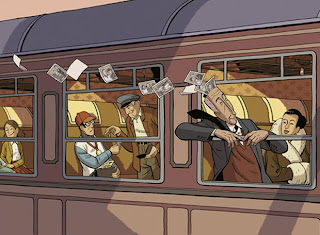Three cherubic Edwardian girls are playing with their pre-plastic dolls in a sunlit rumpus room. Suddenly all at once they look up, stand and walk to three windows in slow motion and leap out. Loud maternal scream off screen. Titles.
Arthur Kipps, a widower, feels little for the son whose birth killed his wife and has sunk so low into the slough of grief for her that his law firm gives him one last chance to redeem himself. Except, he has to spend a week in a ... HAUNTED HOUSE! Carrying a batch of legal papers off to the remote north country wasteland he sees a ghost who does bad things, gets to the bottom of it and .... well, if you see it you won't need spoilers.
This is the latest adaptation of Susan Hill's
The Woman in Black, starring Daniel Radcliffe and Alan Rickman. From the original novel there has been a 1980s television adaptation (which I have seen) by Nigel Kneale, celebrated by its cult as the definitive version and a very very successful stage play by Stephen Mallatrat (which I haven't seen).
Because I am very fond of the Kneale version and knew this one was coming out I decided to contaminate my affection and read the novel.
The Woman in Black is a kind of pacier M.R. James story with passages of real terror. Like all durable horror stories it anchors the weirdness and dread in a human story that is easily identified with.
Kneale's changes in the trek from page to screen served to keep it trim, solid and manageable. Some things couldn't be easily or cheaply filmed at the time. Other things needed compaction for the sake of brevity. The changes Kneale made, however, in each case keep the central theme intact and enhance its relation to the horror of the story.
James Watkins' changes don't do this. While the basic motivation for the ghost remains, its means of destruction is turned from a chilling elegance into the kind of signposting threat that lets us all in on the progress of the narrative from beginning to end, whereby even the big shock ending seems tailored to an audience that expects it and might even expect a refund if it weren't there. And this is the problem with the new Woman in Black, it's not just made to be popular (it should be) it is made to fit form.
The musical score is the tinkly concerto for musical box and orchestra that has been standard fare since about 1962. When it isn't doing that it's busy telling us that we're looking at a big expansive landscape with huge sweeping strings or, in moments of fright, delivering a big BAAAAAAM!!!!!!!!! to let us know that if the images don't get us the volume level will.
On that, Watkins does something I find creepy here and it has nothing to do with haunted houses. There is a sequence late in the first act that involves Arthur dozing off in the haunted house while something very bad is happening. Through an effective mix of vague background motion and some very clear movement seen in a mirror, he builds a real tension. This is the sole moment of the film that has this quality. The rest is a series of sudden shocks and some setups that would be written off as goofy if they weren't so slick.
My point here is that Watkins is showing us that not only does he understand how to set up and use suspense and is a dab hand at it, he is choosing not to use it, he is choosing to please his investors and honour the perceived pact between the multiplex customer and the ticket price, he is saying: I know better -- see this? -- but you are going to get what they say you want, now shut up and prepare for the next scare. It really feels that calculated.
My discomfort with this film stems from this offscreen chill. Watkins and Co. have so resolutely chosen a packaged conventionality over an exploration of the reasons that this story works so well with readers and theatre audiences that its essential ideas are either reduced to such starkness that the audience has no trouble controlling them (and lessening any lasting scares from them) or abandoned altogether, presumably from fear of their being difficult. This goes beyond the point of playing spot the cliche and then beyond the point of simply being popular entertainment and charges straight on to the point where the purchase of a ticket to a horror movie virtually guarantees a minimum because the promise of a real transportation is just not good business.
James Watkins most significant feature film before this was
Eden Lake. It's one of a softly defined trend of pedaphobic horror tales in which adults are terrorised by children who are calling the shots. It's a respectable effort but quite tellingly falls short of its own potential through a preference for showing brutality enacted over suggesting that its source might be disturbingly natural. Still, I was hoping that Watkins might bring something of the appealing rough look and feel of
Eden Lake to
The Woman in Black. No such luck. He produced a perfect and perfectly flavourless feast by following the recipe to the letter and timed it to the second.
It's not garbage but it's not good either. Like J-horror never happened.
 Ringu: you can find the conventionality of this tale but to do so you need to lift layer after layer of innovation and careful craftsmanship. The film that saved the horror genre somewhat ironically by showing the dangers of copying without reading.
Ringu: you can find the conventionality of this tale but to do so you need to lift layer after layer of innovation and careful craftsmanship. The film that saved the horror genre somewhat ironically by showing the dangers of copying without reading. 










































